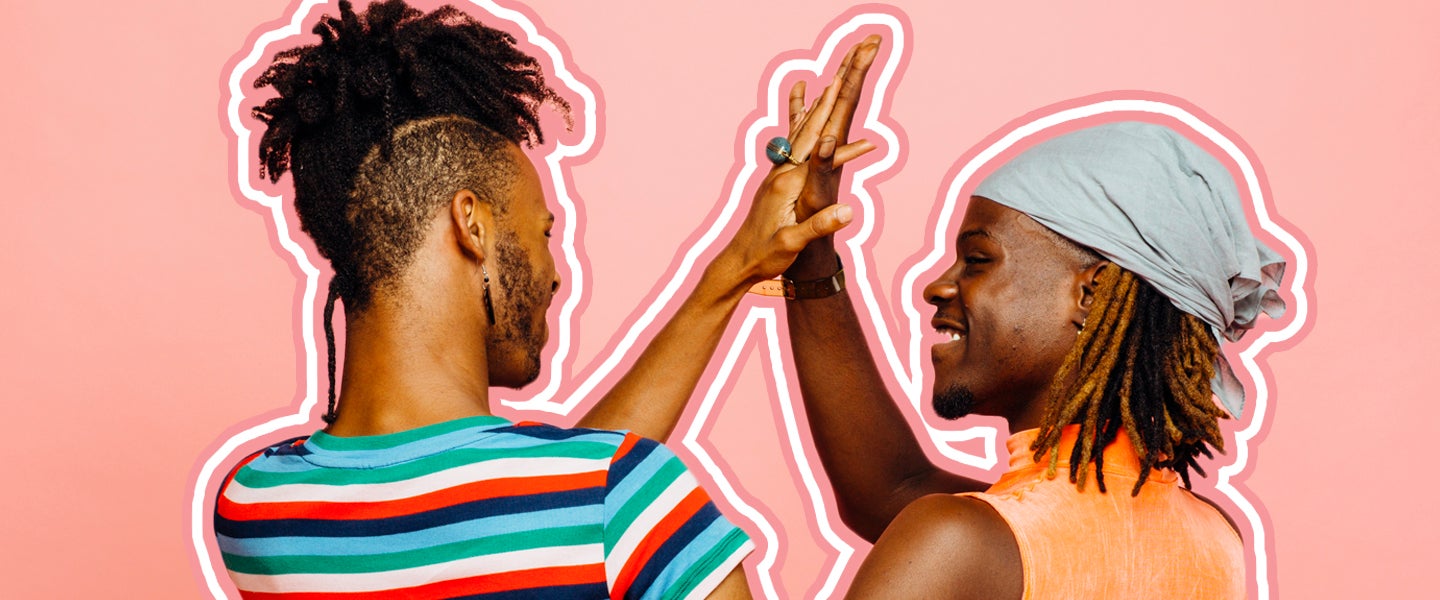In a listicle for Out magazine titled “13 Types of Flirts Every Gay Guy Knows,” writer Zachary Zane claims that gay men don’t flirt like straight men. “Boy, are we a shamelessly flirty community,” he writes. “Gay men, though, don’t have the same cultural dating and flirting scripts that straight men have to deal with, which allows us to flirt however we so choose.”
So far so good, except that the “13 types of flirts” Zane goes on to outline are both a jumbled list of types of gay men with whom one might flirt — like “the shady queen,” “the muscle hunk” and “the ‘straight’ locker room cruiser” — and flirting techniques that are by no means unique to gay men (e.g., touching, whispering and eye-fucking).
I don’t doubt Zane’s claim that gay men flirt differently than straight men, but his list leaves me barely enlightened about the differences. So, to dig a little deeper, I asked more than 30 gay, queer and bisexual men and non-binary people about how they flirt and how their approaches differ from that of straight, cisgender men.
The most obvious and impactful difference is that straight, cisgender men are able to flirt free of the influence of homophobia and transphobia. “I rarely flirt, because on top of being queer, I’m also a trans man, and I don’t want to be harassed, beaten or killed,” says Sam, 23, from Utah. “I’ll only bother if the space is designed around accepting trans people.” Several other sources agree that these background threats lead to hyper-vigilance and caution. “If I’m in public and not at a gay bar or event, there’s a wall that exists because of a fear of outing the other person,” Will, a 30-year-old gay man in L.A., tells me. “It’s always there for me in particular, because I’m attracted to older men who present pretty straight.”
Enrique, a 30-year-old gay man from Venezuela, says that his cultural setting makes flirting even more difficult, especially in person. “We have more restrictions, because most of our families are old school, with all that ‘macho Latino’ stuff on their minds,” he explains. “We have more homophobic incidents, so we use apps and online communication to meet other gays. Other cultures taught us that you can flirt in coffee shops, in bars and on the subway, but personally, I couldn’t experience all that.”
Because of these risks, several of my sources tell me that flirtation based on eye contact, body language, gestures and other subtle signaling has become crucial. “Gays will rarely, if ever, approach without a complex web of body language and stares, especially in straight spaces,” says Daniel, a non-binary, gay 23-year-old based in New Jersey. “There’s a long history of using these hints, because there was no other way of being gay if you weren’t in some urban epicenter or endangering yourself in a club that could be raided at any moment.”
This, though, can lead some gay men and non-binary people to make use of a direct and overtly sexual flirting style. “Straight people have to play a more extended flirting game — in Spain, we call it the pickax and shovel,” Xisco, a 24-year-old gay Spaniard says. “Whereas for gay guys, it’s like, ‘Let’s not make it even more complicated than it already is.’” Michael, a 35-year-old Californian, agrees. “I’m gay and masculine, and I’m fully the Direct Dude,” he tells me. “I’m openly thirsty and always down to talk about butts and who I want to bang.” Some of my bisexual sources echo this sentiment. “I tend to be more jokey and conversational with women and more direct with men,” says Tim, a 29-year-old bisexual guy from Alabama. “Usually flirting with men gets more risqué quicker.”
But theirs is far from a universal experience. Maven, a 24-year-old bisexual trans man in Florida, tells me that “the headache that comes with being trans” combined with undiagnosed autism spectrum disorder means that flirting is basically a no-go, and two other guys add that, for them at least, flirting is mostly a cerebral activity. “When I was flirting pre-transition, I focused heavily on body language and touch,” says Sev, a 22-year-old gay trans man in Connecticut. “Now I find myself letting go of the feeling that I have to use bodily cues at all.” Skylor, a 25-year-old queer, trans man from Chicago, also describes his flirting style as “passive” and centered on an “emotional or intellectual connection.”
Several of my sources agree with Zane that there’s no cultural script telling them how to flirt, which they, too, find freeing. “There’s more pressures to do ‘the right thing’ [when I flirt with women], like acting super suave like the guys in the movies,” Zak, a 25-year-old bisexual in the U.K., explains, adding that they find it easier to flirt with men and non-binary people. “The lack of script is freeing — I can be myself and not like a Ryan Gosling type. If there’s no script, how can I be criticized for going off of it? I feel a lot more able to be my normal geeky self, whether that’s getting into sharing a TV show together or talking about movies, games or books.”
The requirement to go “off-script” combined with the hyper-vigilance and caution required in IRL locations means that online spaces are increasingly important, and there’s a strong tendency for LGBTQ people to bond over cultural touchstones and shared interests in these zones. “The wildest part of the gay cis male experience today is how much of it exists online, specifically Twitter and Instagram,” says my colleague Joseph Longo. “You have these 19-year-old newly out twinks flirting with men twice their age on Twitter over whatever played-out Gaga meme is popular that day. So much of my flirting has become witty, snarky responses and the occasional selfie for posterity.”
Despite the background of bigotry and fear described above, many of my sources say their flirtation is more joyous, interesting and satisfying than what occurs in straight encounters, where there’s less of an emphasis on trying to relate to someone else. “A lot of cishet dudes in my experience view flirting only as a means to an end and not an active process or even a thing they should work on,” says Michael, a 23-year-old queer man from New York, adding that straight men are particularly reluctant to enjoy or bond over media that isn’t made with them in mind. “They laugh off boy bands; they made a whole generation hate Justin Bieber, and they made fun of Twilight instead of learning from it. Straight dudes just refuse to process why women are into [this stuff] — there’s definitely less enjoyment.”
And for Enrique, one of the key things straight men miss out on is approaching each other on equal footing. “When you’re flirting with someone special [in the gay community], you look for themes in common and start there — as equals,” he tells me. “Whereas I think straight men are always like, ‘Hey, I’m the alpha. I’m going to protect you.’”
In other words, seeing someone as a whole person and not a set of stereotypical gender roles could be the best flirting technique of all.

